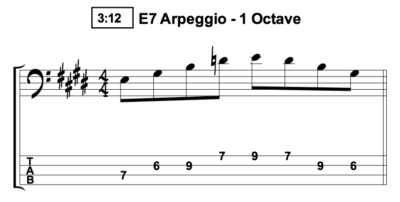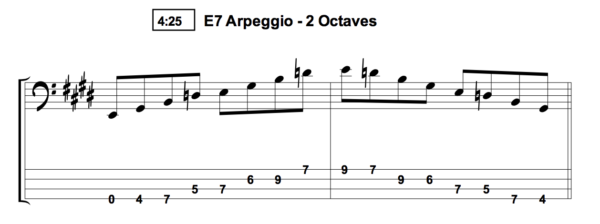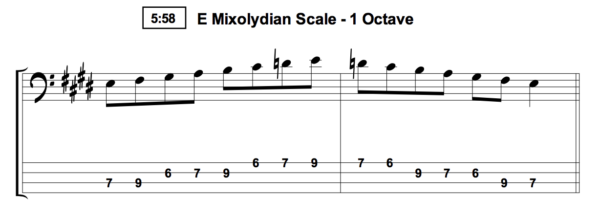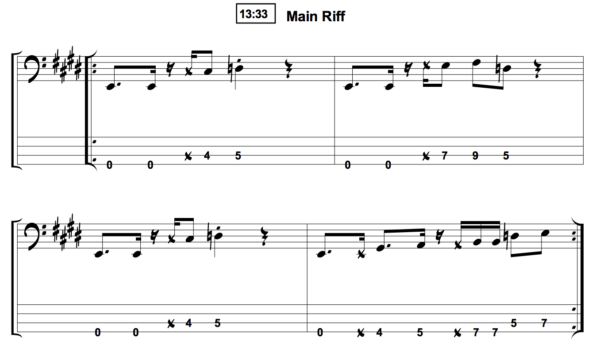In this lesson I’ll be expanding on the previous ‘Funky Bass Line’ lesson by showing you how we can add scale notes into our riff.
Recap
Last lesson, we created a bass groove by doubling the kick drum pattern and used the notes of a D7 chord. We are going to expand on that groove today and learn how you can apply scale notes to your bass lines.
Today’s riff is based around an E7 chord. Although we are just playing along to drums, we still need a key centre and chords so the song can work with other instruments.
The tones of the chord should always be the framework you work around as it is the harmonic landscape of the tune.
As bass players, our functional role is to act as the connection between the rhythm and the harmony. We want to outline the chord progression while locking in with the drummer and reinforcing the necessary accents in the rhythm.
Let’s look at the notes in E7:

This is the arpeggio of E7 and the notes are E, G#, B and D. Learning a one-octave shape of this scale is important, but it does limit the notes we have available to us. To extend this shape, we can start an octave lower and play the arpeggio twice over two octaves.

Turning A Chord Into A Scale
Every chord we come across has a parent scale that the arpeggio is built from. For E7, it is the E Mixolydian scale. This is because E7 is the fifth chord in the key of A major and E Mixolydian is the mode built off of this scale degree.
E7 – E G# B D
E Mixolydian – E F# G# A B C# D

Extending The Mixolydian Scale
Like we did with the arpeggio, it is worth extending the E Mixolydian scale over two octaves to make it more useful for our bass line.

Adding Scale Notes To A Riff
Now we are familiar with the E7 arpeggio and the E Mixolydian scale, we need to know how to use them over an E7 chord. The arpeggio is fairly straight forward as there are only five notes and they will all work over the chord. With the scale, however, we need to be a bit more careful with when and where we place each tone.
The first thing to be aware of is the fact that the scale is made up of seven different notes, but only three of them are non-chord tones.
E F# G# A B C# D
The notes in red are in the chord of E7, so the only non-chord tones in the scale are F#, A and C#.
The 2nd, 4th and 6th (F#, A and C#), are the scale tones we want to use in our riff. However, we want to use them in passing and shouldn’t linger on them for long. They can be used for effect to create tension, but you should be in control of this know how to resolve it.
The next riff incorporates each of the three non-chord tones and shows how you can use them as individual notes for their own flavour.














Mark this was nice , I like the drum beat , I cant play my bass , waiting on a string delivery and cleaned up my bass all ready for new strings.
I wanted to ask you I’ve done everything I know to do to get my strings lower.
The only thing I haven’t done is shim the neck but am afraid of taking my neck off.
Those 4 screws looks easy to do but would you do this , take your bass neck off lay done something to bring the neck up a bit. My bass is a 2014 Standard Fender Jazz MIM.
Please let me know.
Hi Mark, I will jump in with a general comment about lowering strings. You didn’t say exactly what you have done so far, so it’s hard to tell whether you are at the point where shimming the neck makes sense. There are lots of vids on YouTube showing how to properly set up a bass, and for a basic setup it is not terribly hard to do as long as the instrument does not have any gross problems such as a back-bowed or seriously twisted neck, broken truss rod, etc.
At this point, I can’t say whether it makes sense to do it yourself or to take it to a shop – BUT the Fender you have is a reasonably high quality instrument (ie – it’s not a ‘beginner’ class instrument) and it might be well worth it to invest in a professional setup to get it in proper working order, at least this first time around. Once any serious problems (if any) are corrected, doing basic setup and maintenance on the instrument is something every bass player should learn to do – as well as learning to play the instrument, of course!
Best luck. ~ Sam
Sam thanks for your reply , I have my strings as low as they will go without fret buzz or the shim.
Here where I live in Houston the weather changes dramatically with humidity during the summer and damp cold during the winter , this makes big changes on the bass neck.
I do need to bring my bass to a qualified luthier to get it set up correctly.
I changed the factory set up a lot but it seems to be okay.
I took this bass out of the box in 2014 , it’s nice.
Thanks ‘
Sam I forgot to mention when applying new strings I found if I bend the string over the saddle & at the nut it lowers the string quit a bit. Small things like this I’ve learned over the past 3 years helped me figure out adjustments on my own. I need to do this myself , some people are afraid of the elusive truss rod , darn that mysterious truss rod.
I make very small turns , retune and try again , then leave it for a day so the wood can set.
Youtube has helped me a very much , sure wish we had this when I was younger , I had a 15 year lay off from bass because I lost interest , not anymore.
Mark Smith is the reason why I bought this Fender , my 1985 Ibanez EX 404 has seen better days , it needs to be rewired , I need to sell it , it’s still a nice bass but I’ve always wanted a Fender Jazz bass.
And yes learning to play , I was frustrated at first with vibrating strings , I refuse to use a string dampener. Learning to get in ghost notes & plucks on time took patients & time.
Ultimately it takes time to learn bass , seems nowadays everyone wants everything fast ,,,
fast food-yuk , fast this , fast that , everyone wants things fast. Not true with learning bass , it takes much patience & time to which I have plenty of nowadays.
Thanks for your reply and reading my gibberish.
Hey Mark, at this point you must get tired of hearing how great your video lessons are and what a great teacher you are, etc., etc. But THAT was a GREAT lesson!
Well done Mr. Mark….
Good lesson. I learn some new approach every time I watch your lessons even though I start out watching and thinking,’I know this stuff’ ……you always add some value to my existing knowledge. Invaluable. Thanks.
Mark, another great lesson, thanks. I have some knowledge of scales, 7ths, etc, but this lesson put a great deal of my knowledge into a new and very interesting context. I have come a long wat from jsut root to 5th due to your lessons.Thanks from a new and ardent 64 year old new bass player in New Zealand.
i like how he said you cant just randomly play the scale notes, i been doing that for years its part of the fun